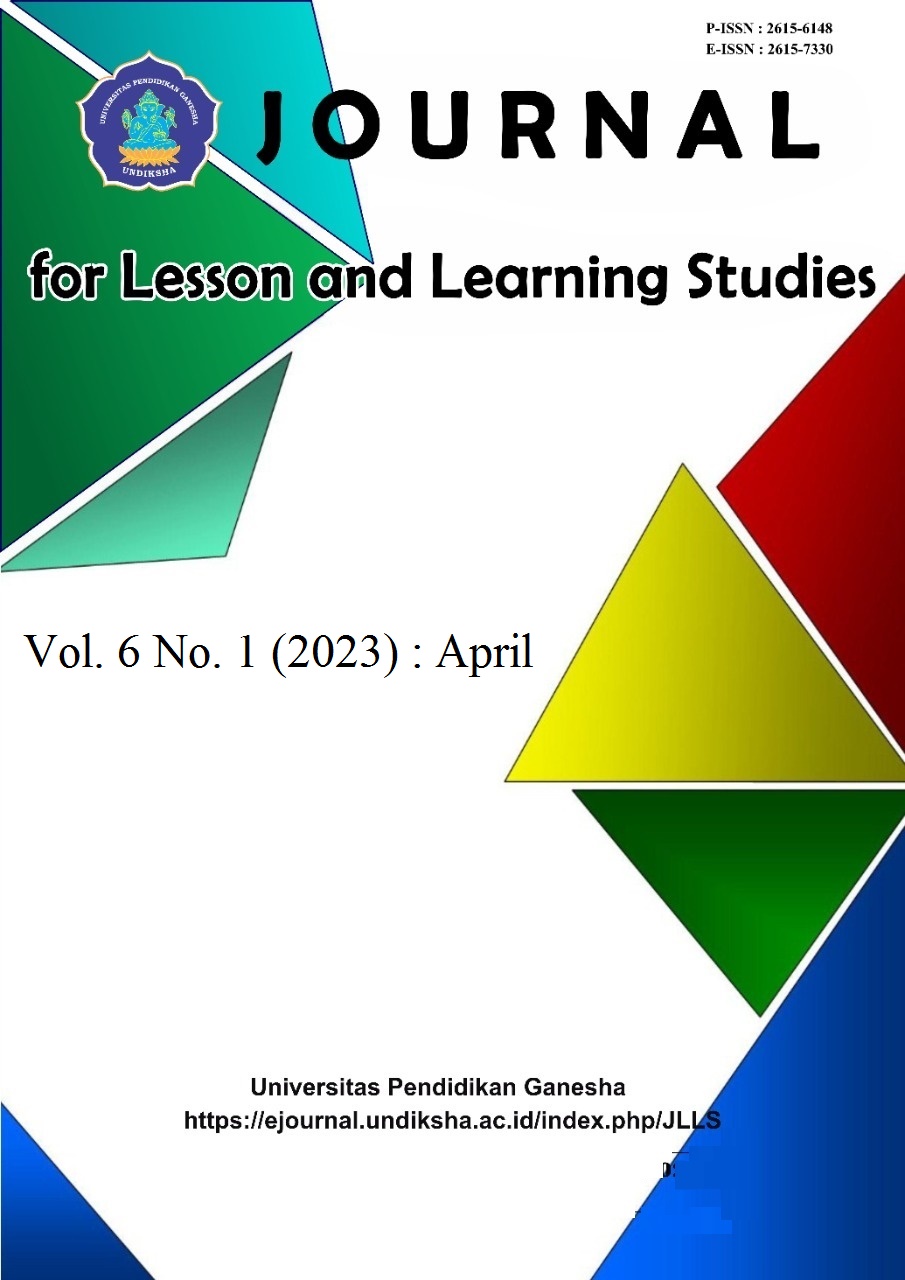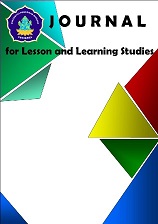Mobile Learning Improves Student Learning Outcomes in Mathematics Education
DOI:
https://doi.org/10.23887/jlls.v6i1.61417Kata Kunci:
Mobile Learning, Learning OutcomesAbstrak
This study discusses how the resulting influence on student learning outcomes using Mobile Learning (ML). The research was conducted at the Bachelor of Mathematics Education Study Program, Singaperbangsa University, Karawang in semester III of 96 students from three classes which constituted the population as well as the sample in this study as a whole. This study examines how the influence of the application of Mobile Learning on student learning outcomes, which will be seen based on student ability groups (High Category, Medium Category, Low Category), then based on each class (Class A, Class B, Class C), and overall students. The method used in this study is quantitative with the One Sample Group Posttest Design, with learning outcomes taken from the final grades of the learning process by applying mobile learning to the Linear Algebra Course. The results of this research are as follows; 1). The effect of Mobile Learning (ML) on the student learning outcomes group for the high category did not give any effect, but the student learning outcomes group for the medium and low categories did have an influence. 2). The influence of Mobile Learning (ML) on student learning outcomes in each class, namely class A, class B, and class C, shows a significant influence, so it is good to be given to any class. 3). The influence of Mobile Learning (ML) on student learning outcomes as a whole shows a significant influence
Referensi
Agustina, M., Azizah, E. N., & Koesmadi, D. P. (2021). Pengaruh Pemberian Reward Animasi terhadap Motivasi Belajar Anak Usia Dini selama Pembelajaran Daring. Jurnal Obsesi : Jurnal Pendidikan Anak Usia Dini, 6(1), 353–361. https://doi.org/10.31004/obsesi.v6i1.1331. DOI: https://doi.org/10.31004/obsesi.v6i1.1331
Albab, S. U. (2020). Analisis kendala pembelajaran e-learning pada era disrupsi di SMK Terpadu Al-Islahiyah Singosari Malang. Mudir: Jurnal Manajemen Pendidikan, 2, 46–57. https://doi.org/10.55352/mudir.v2i1.105.
Andarwulan, T., Al Fajri, T. A., & Damayanti, G. (2021). Elementary teachers’ readiness toward the online learning policy in the new normal era during Covid-19. International Journal of Instruction, 14(3), 771–786. https://doi.org/10.29333/iji.2021.14345a. DOI: https://doi.org/10.29333/iji.2021.14345a
Arizona, K., Abidin, Z., & Rumansyah, R. (2020). Pembelajaran Online Berbasis Proyek Salah Satu Solusi Kegiatan Belajar Mengajar Di Tengah Pandemi Covid-19. Jurnal Ilmiah Profesi Pendidikan, 5(1). https://doi.org/10.29303/jipp.v5i1.111. DOI: https://doi.org/10.29303/jipp.v5i1.111
Bano, M., Zowghi, D., Kearney, M., Schuck, S., & Aubusson, P. (2018). Mobile learning for science and mathematics school education: A systematic review of empirical evidence. Computers and Education. https://doi.org/10.1016/j.compedu.2018.02.006. DOI: https://doi.org/10.1016/j.compedu.2018.02.006
Brooker, A., Corrin, L., de Barba, P., Lodge, J., & Kennedy, G. (2018). A tale of two MOOCs: How student motivation and participation predict learning outcomes in different MOOCs. Australasian Journal of Educational Technology, 34(1), 73–87. https://doi.org/10.14742/ajet.3237. DOI: https://doi.org/10.14742/ajet.3237
Chen, C.-H., & Tsai, C.-C. (2021). In-service teachers’ conceptions of mobile technology-integrated instruction: Tendency towards student-centered learning. Computers & Education, 170(1). https://doi.org/10.1016/j.compedu.2021.104224. DOI: https://doi.org/10.1016/j.compedu.2021.104224
Chen, Y. F., Luo, Y. Z., Fang, X., & Shieh, C. J. (2018). Effects of the application of computer multimedia teaching to automobile vocational education on students’ learning satisfaction and learning outcome. Eurasia Journal of Mathematics, Science and Technology Education, 14(7). https://doi.org/10.29333/ejmste/91245. DOI: https://doi.org/10.29333/ejmste/91245
Churchill, D., Fox, B., & King, M. (2016). Framework for Designing Mobile Learning Environments. In Lecture Notes in Educational Technology. Springer International Publishing, 9789811000256, 3–25. https://doi.org/10.1007/978-981-10-0027-0_1. DOI: https://doi.org/10.1007/978-981-10-0027-0_1
Creswell, J. (2012). Design: Choosing Among Five Approaches. In Design: Choosing Among Five Approaches (Vol 3, Number June).
Darmaji, Kurniawan, D. A., Astalini, & Nasih, N. R. (2019). Persepsi Mahasiswa pada Penuntun Praktikum Fisika 1059 Dasar II Berbasis Mobile Learning. Jurnal Pendidikan: Teori, Penelitian, dan Pengembangan, 4(4), 516–523. https://doi.org/10.17977/jptpp.v4i4.12345. DOI: https://doi.org/10.17977/jptpp.v4i4.12345
David, & Schwaninger, A. (2021). Technology acceptance of four digital learning technologies (classroom response system, classroom chat, e-lectures, and mobile virtual reality) after three months’ usage. International Journal of Educational Technology in Higher Education, 18(1), 1–17. https://doi.org/10.1186/s41239-021-00243-4. DOI: https://doi.org/10.1186/s41239-021-00243-4
Dike, D., Parida, L., & Stevanus, I. (2020). Micro Strategy And Character Educational Transformation In Elementary School During The Covid-19 Pandemic of Sintang Distric, West Kalimantan Province. European Journal of Molecular and Clinical Medicine, 7(8), 775–786.
Fikri, M., Ananda, M. Z., & Faizah, N. (2021). Kendala Dalam Pembelajaran Jarak Jauh di Masa Pandemi Covid-19 : Sebuah Kajian Kritis. Jurnal Education and development, 9(1), 145–148. https://doi.org/10.37081/ed.v9i1.2290.
Fitriyani, Y., Fauzi, I., & Sari, M. Z. (2020). Motivasi Belajar Mahasiswa Pada Pembelajaran Daring Selama Pamdemic Covid-19. Jurnal Kependidikan, 6(2), 165–175. https://doi.org/10.33394/jk.v6i2.2654. DOI: https://doi.org/10.33394/jk.v6i2.2654
García-Martínez, I., Fernández-Batanero, J. M., Sanchiz, D. C., & de la Rosa, A. L. (2019). Using mobile devices for improving learning outcomes and teachers’ professionalization. Sustainability (Switzerland), 11(24), 1–12. https://doi.org/10.3390/su11246917. DOI: https://doi.org/10.3390/su11246917
Habiba, B., Mulyani, S., Nia, N. I., & Nugroho, P. (2020). Konsep Layanan Responsif bagi Siswa yang Mengalami Kesulitan Belajar secara Daring Dimasa Pandemi Covid-19. KONSELING EDUKASI “Journal of Guidance and Counseling”, 4(2), 305–322. https://doi.org/10.21043/konseling.v4i2.7583. DOI: https://doi.org/10.21043/konseling.v4i2.7583
Hapsari, T. P. R. N., & Fitria, A. S. (2020). Efektivitas Pembelajaran Daring Mata Kuliah Evaluasi Pengajaran Bahasa Dan Sastra Indonesia Masa Pandemi Covid-19. Jurnal Ilmiah SEMANTIKA, 2(01), 11–20. https://doi.org/10.46772/semantika.v2i01.259. DOI: https://doi.org/10.46772/semantika.v2i01.259
Herdiana, D., Rudiana, R., & Supriatna, S. (2021). Kejenuhan Mahasiswa dalam Mengikuti Perkuliahan Daring dan Strategi Penanggulangannya. Edunesia : Jurnal Ilmiah Pendidikan, 2(1), 293–307. https://doi.org/10.51276/edu.v2i1.128. DOI: https://doi.org/10.51276/edu.v2i1.128
Hutauruk, A., & Sidabutar, R. (2020). Kendala pembelajaran daring selama masa pandemi di kalangan mahasiswa pendidikan matematika: Kajian kualiatatif deskriptif. Journal of Mathematics Education and Applied, 02(01), 45–51. https://doi.org/10.36655/sepren.v2i1.364. DOI: https://doi.org/10.36655/sepren.v2i1.364
Imelda, C. B., & Astuti, U. (2019). Effect of process writing approach combined with video-based mobile learning on Indonesian EFL learners’ writing skill across creativity levels. International Journal of Instruction, 12(3). https://doi.org/10.29333/iji.2019.12320a. DOI: https://doi.org/10.29333/iji.2019.12320a
Kadafi, A., Alfaiz, A., Ramli, M., Asri, D. N., & Finayanti, J. (2021). The impact of islamic counseling intervention towards students’ mindfulness and anxiety during the covid-19 pandemic. Islamic Guidance and Counseling Journal, 4(1), 55–66. https://doi.org/10.25217/igcj.v4i1.1018. DOI: https://doi.org/10.25217/igcj.v4i1.1018
Kattayat, S., Josey, S., & Asha, J. V. (2017). Mobile learning apps in instruction and students achievement. International Journal of Interactive Mobile Technologies, 11(1), 143–147. https://doi.org/10.3991/ijim.v11i1.6420. DOI: https://doi.org/10.3991/ijim.v11i1.6420
Kristiawan, M., Aminudin, N., & Rizki, F. (2021). Optimalisasi Pembelajaran Daring Berbasis Aplikasi Online bagi Calon Guru Pendidikan Anak Usia Dini. Jurnal Obsesi, 5(2), 1905 – 1914. https://doi.org/10.31004/obsesi.v5i2.942. DOI: https://doi.org/10.31004/obsesi.v5i2.942
Lai, C. L., & Hwang, G. J. (2014). Effects of Mobile Learning Participation Time on High School Students’ 21st Century Core. International Confrence of Educational Innovation Through Technology IEEE Computer Society, 1. https://doi.org/10.1109/EITT.2014.40. DOI: https://doi.org/10.1109/EITT.2014.40
Latifa, N. A., Lufri, L., & Zulyusri, Z. (2021). The Problem of Online Learning in Covid-19 toward Learning Process Problematika Pembelajaran Daring di Tengah Wabah Covid-19 terhadap Proses. Bioeducation Journal, 5(1), 19–26. https://doi.org/10.24036/bioedu.v5i1.292.
Mahendra, I. W. E. (2017). Project Based Learning Bermuatan Etnomatematika Dalam Pembelajar Matematika. JPI (Jurnal Pendidikan Indonesia). https://doi.org/10.23887/jpi-undiksha.v6i1.9257. DOI: https://doi.org/10.23887/jpi-undiksha.v6i1.9257
Mansur, H., Jumadi, Mastur, Utama, A. H., & Prastitasari, H. (2021). The Problem of Distance Learning During the Covid-19 Pandemic. Ilkogretim Online - Elementary Education Online, 20(4), 168–175. https://doi.org/10.17051/ilkonline.2021.04.19.
Muswita, Utomo, A. B., Yelianti, U., & Wicaksana, E. J. (2018). Pengembangan E-Book Berbasis Mobile Learning Pada Mata Kuliah Struktur Tumbuhan. Pendidikan Biologi, 11, 93–104. https://doi.org/10.20961/bioedukasi-uns.v11i2.23814.
Nikolopoulou, K., & Kousloglou, M. (2019). Mobile Learning in Science: A Study in Secondary Education in Greece. Creative Education, 10(06), 1271–1284. https://doi.org/10.4236/ce.2019.106096. DOI: https://doi.org/10.4236/ce.2019.106096
Oktavian, R., & Aldya, R. F. (2020). Efektivitas Pembelajaran Daring Terintegrasi di Era Pendidikan 4.0. Didaktis: Jurnal Pendidikan dan Ilmu Pengetahuan, 20(2), 129–135. https://doi.org/10.30651/didaktis.v20i2.4763. DOI: https://doi.org/10.30651/didaktis.v20i2.4763
Primasari, I. F. N. D., & , Zulela, F. (2019). Model Mathematics Realistic Education (RME) Pada Materi Pecahan di Sekolah Dasar. Jurnal Basicedu, 1(1), 1–9. https://doi.org/10.31004/basicedu.v5i4.1115. DOI: https://doi.org/10.31004/basicedu.v5i4.1115
Purwitaningrum, R., & Prahmana, R. C. I. (2021). Developing instructional materials on mathematics logical thinking through the Indonesian realistic mathematics education approach. International Journal of Education and Learning, 3(1), 13–19. https://doi.org/10.31763/ijele.v3i1.178. DOI: https://doi.org/10.31763/ijele.v3i1.178
Rachmavita, F. P. (2020). Interactive media-based video animation and student learning motivation in mathematics. Journal of Physics: Conference Series, 1663(1). https://doi.org/10.1088/1742-6596/1663/1/012040. DOI: https://doi.org/10.1088/1742-6596/1663/1/012040
Rahma, N. A., & Pujiastuti, H. (2021). Efektivitas Pembelajaran Daring Matematika Pada Masa Pandemi Covid-19 Di Kota Cilegon [the Effectiveness of Mathematics Online Learning During the Covid-19 Pandemic in Cilegon City]. JOHME: Journal of Holistic Mathematics Education, 5(1), 1. https://doi.org/10.19166/johme.v5i1.3811. DOI: https://doi.org/10.19166/johme.v5i1.3811
Santagata, R., & Yeh, C. (2014). Learning to teach mathematics and to analyze teaching effectiveness: Evidence from a video- and practice-based approach. Journal of Mathematics Teacher Education, 17(6), 491–514. https://doi.org/10.1007/s10857-013-9263-2. DOI: https://doi.org/10.1007/s10857-013-9263-2
Sari, R. S., Ningsi, N., Nasarudin, N., & Hakim, A. R. (2023). Free Inquiry Learning Model with Experimental Methods on The Learning Outcomes of Class X Students of Senior High School on The Subject of Motion. Jurnal Pendidikan Fisika Indonesia, 18(2), 165–173. https://doi.org/10.15294/jpfi.v18i2.28083. DOI: https://doi.org/10.15294/jpfi.v18i2.28083
Sinnayah, P., Rathner, J. A., Loton, D., Klein, R., & Hartley, P. (2019). A combination of active learning strategies improves student academic outcomes in first-year paramedic bioscience. Advances in physiology education, 43(2). https://doi.org/10.1152/advan.00199.2018. DOI: https://doi.org/10.1152/advan.00199.2018
Skiada, R., Soroniati, E., Gardeli, A., & Zissis, D. (2014). EasyLexia: A Mobile Application for Children with Learning Difficulties. Procedia Computer Science, 27. https://doi.org/10.1016/j.procs.2014.02.025 DOI: https://doi.org/10.1016/j.procs.2014.02.025
Sugiyono. (2019). Metode Penelitian Pendidikan (Kuantitatif, Kualitatif, Kombinasi, R & D dan Penelitian Pendidikan). Alfabeta.
Suprianto, A., Ahmadi, F., & Suminar, T. (2019). The development of mathematics mobile learning media to improve students’ autonomous and learning outcomes. Journal of Primary education, 8(1). https://doi.org/10.2991/assehr.k.200827.115. DOI: https://doi.org/10.2991/assehr.k.200827.115
Szabo, Z. K., Körtesi, P., Guncaga, J., Szabo, D., & Neag, R. (2020). Examples of Problem-Solving Strategies in Mathematics Education Supporting The Sustainability of 21st-Century Skills. Sustainability, 12(23), 1–28. https://doi.org/10.3390/su122310113. DOI: https://doi.org/10.3390/su122310113
Ulinsa, U., Rinaldi, R., & Oringo, V. (2021). The Problem of Language Teachers In Online Learning During The Pandemic An Analysis Of Teaching Discourse In Schools. Journal of Pragmatics and Discourse Research, 1(2). https://doi.org/10.51817/jpdr.v1i2.183. DOI: https://doi.org/10.51817/jpdr.v1i2.183
Zhou, Y., Feng, L., Zhang, X., Wang, Y., Wang, S., & Wu, T. (2021). Spatiotemporal patterns of the COVID-19 control measures impact on industrial production in Wuhan using time-series earth observation data. Sustainable Cities and Society, August, 103388. https://doi.org/10.1016/j.scs.2021.103388. DOI: https://doi.org/10.1016/j.scs.2021.103388
Unduhan
Diterbitkan
Cara Mengutip
Terbitan
Bagian
Lisensi
Hak Cipta (c) 2023 Dori Lukman Hakim

Artikel ini berlisensiCreative Commons Attribution-ShareAlike 4.0 International License.
Authors who publish with the Journal for Lesson and Learning Studies agree to the following terms:
- Authors retain copyright and grant the journal the right of first publication with the work simultaneously licensed under a Creative Commons Attribution License (CC BY-SA 4.0) that allows others to share the work with an acknowledgment of the work's authorship and initial publication in this journal.
- Authors are able to enter into separate, additional contractual arrangements for the non-exclusive distribution of the journal's published version of the work (e.g., post it to an institutional repository or publish it in a book), with an acknowledgment of its initial publication in this journal.
- Authors are permitted and encouraged to post their work online (e.g., in institutional repositories or on their website) prior to and during the submission process, as it can lead to productive exchanges, as well as earlier and greater citation of published work. (See The Effect of Open Access)





